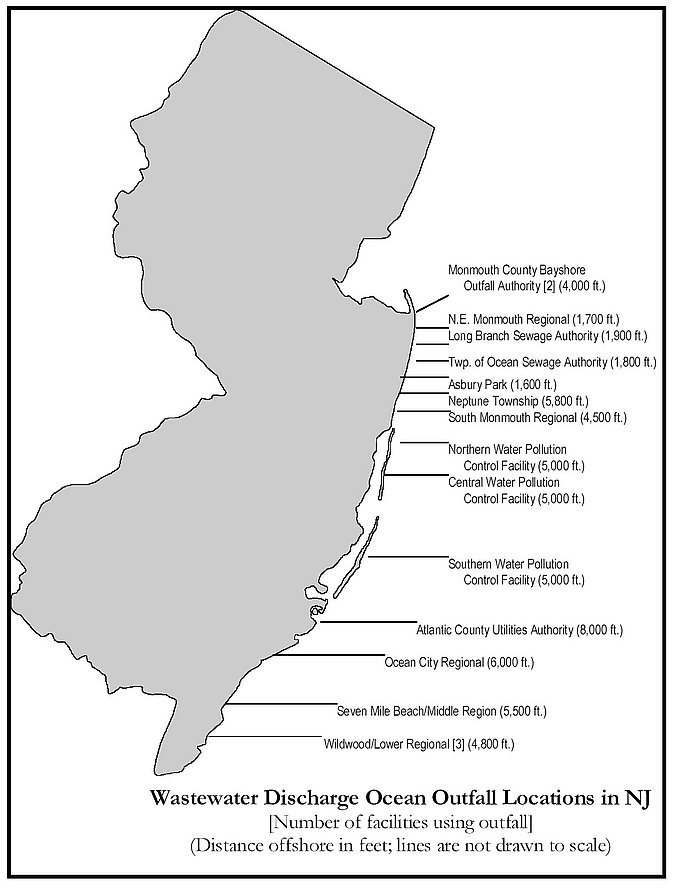Where Does Effluent Go?
Fourteen permitted ocean dischargers along the New Jersey shoreline, ranging from Cape May County to Monmouth County, pump our treated wastewater into the Atlantic Ocean.
Is There an Outfall Pipe Near You? (Town/Street and Distance Offshore*)
Remember: All pipes from these facilities discharge east into the Atlantic Ocean
- Ventnor City ( S. Delancy Place): 8,000 feet
- Southern Wildwood Crest (Jefferson Avenue): 4,800 feet
- Southern Ocean City (46th Street): 6,000 feet
- Avalon (30th Street): 5,530 feet
- Northern Asbury Park (~ 7th & 8th Streets): 1,600 feet
- Southern Sandy Hook (near Highlands Bridge): 4,000 feet
- Seven Presidents Park (south end): 1,920 feet
- Monmouth Beach (~ Cottage Road): 1,762 feet
- Belmar & Spring Lake (North & South Blvds. (Twin Arches)): 4,480 feet
- Avon-by-the-Sea & Bradley Beach (Sylvan Lake): 5,800 feet
- Deal (~ Roosevelt Avenue): 1,800 feet
- South-end of South Seaside Park (23rd Avenue): 5,000 feet
- Mantoloking (~ Princeton Avenue): 5,000 feet
- Ship Bottom Borough (5th Street): 5,000 feet
*5,280 feet = 1 mile
Most of the effluent is freshwater that has been taken from nearby sources to use during the treatment process. This discharged freshwater is destroyed in the ocean and becomes saltwater, depleting our natural freshwater supply.
In 1998 alone, 65 billion gallons of freshwater effluent was pumped into the ocean. If all 65 billion gallons were poured into milk gallon jugs and lined up end to end, they would stretch 10,258,838 miles, and circle the Earth 412 times.
The Outfall System
Effluent flows from wastewater treatment plants via long pipelines called outfalls. Outfalls or dischargers can range from an open-ended pipe to a multiple port diffuser. The outfalls lie between 1,600 feet (in Monmouth Beach) and 8,000 feet (in Atlantic City) from the shore. The outfall is either a long concrete or steel pipeline, which runs along the ocean floor, from the treatment plant directly to the diffuser. A diffuser is like a sieve with up to several hundred holes, which release the effluent into the ocean over the distance of the diffuser.
The Diffusion Zone
Once freshwater effluent has been discharged into the saltwater environment, dilution begins. The effluent rises from the diffuser where it mixes with ocean water. The rising brew of freshwater and saltwater mixing is a mixing zone and wastefield. At some distance from the outfall, the effluent plume is undetectable because of complete mixing and dilution. The distance that a plume travels depends on many conditions in the ocean, including tides, currents, winds, and salinity.
The mixing zone can contain significantly high levels of toxins since statewide water quality standards and regulations do not have to be met until the water reaches the boundary of the mixing zone. This means that effluent and marine waters in the mixing zone do not necessarily meet the standards and regulations for clean water.


